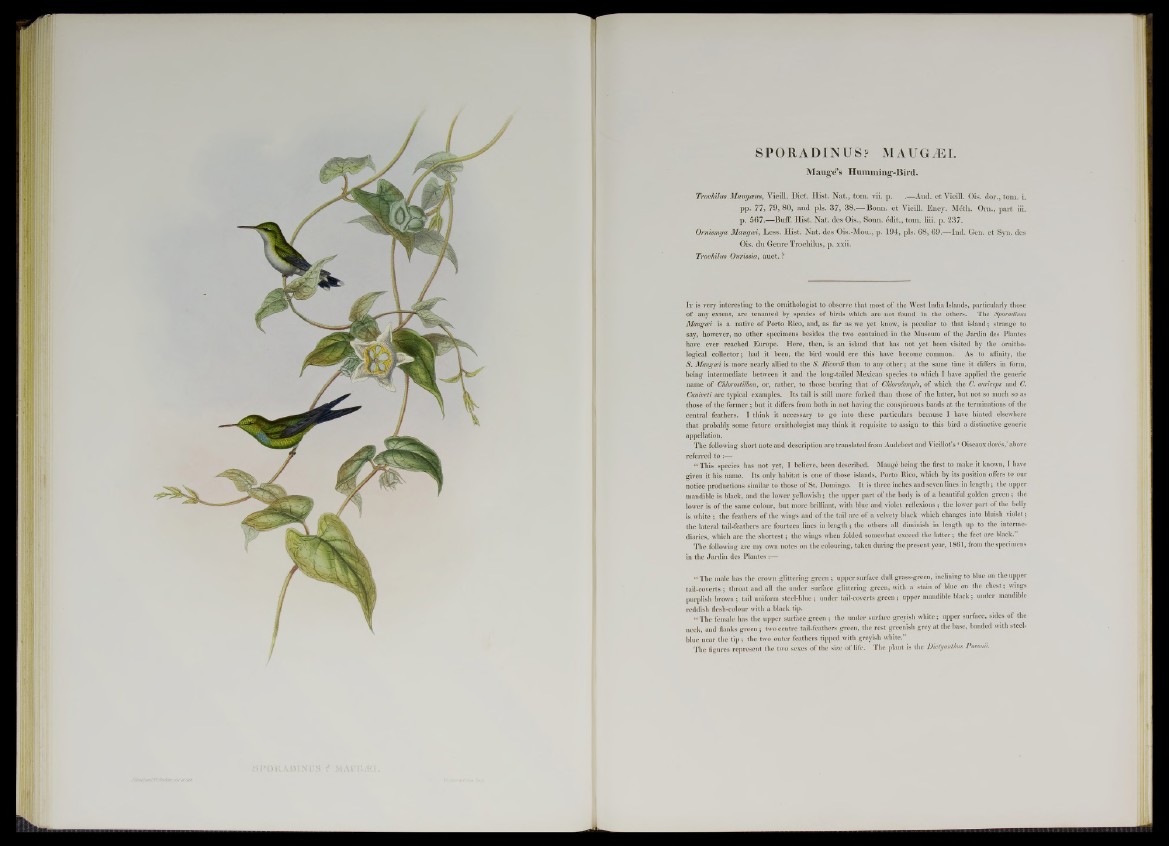
SPORADINUS? MAUGJ3I.
M a u d ’s Humming-Bird.
Trochilus Maugceus, Vieill. Diet. H ist. N a t., tom. vii. p. .— Aud. e t Vieill. Ois. dor., tom. i.
p p . 77, 79, 80, and pis. 37, 38.— Bonn, e t Vieill. Ency. M£th. Om., part iii.
p. 567.—Buff. Hist. N at. des Ois., Sonn. ¿dit., tom. liii. p. 237.
Ornismya Maugcei, Less. Hist. N a t. des Ois.-Mou., p. 194, pis. 68, 69.— Ind. Gen. e t Syn. des
Ois. du Genre Trochilus, p. xxii.
Trochilus Ourissia, auct. ?
It is very interesting to the ornithologist to observe that most of the West India Islands, particularly those
of any extent, are tenanted by species of birds which are not found in the others. The Sporadinus
Maugcei is a native of Porto Rico, and, as far as we yet know, is peculiar to that island; strange to
say, however, no other specimens besides the two contained in the Museum of the Jardin des Plantes
have ever reached Europe. Here, then, is an island that has not yet been visited by the ornithological
collector; had it been, the bird would ere this have become common. As to affinity, the
S. Maugcei is more nearly allied to the S. Ricordi than to any other; at the same time it differs in form,
being intermediate between it and the long-tailed Mexican species to which I have applied the generic
name of Chlorostilbon, or, rather, to those bearing that of Chlorolampis, of which the C. anriceps and C.
Caniveti are typical examples. Its tail is still more forked than those of the latter, but not so much so as
those of the former; but it differs from both in not having the conspicuous bands at the terminations of the
central feathers. I think it necessary to go into these particulars because I have hinted elsewhere
that probably some future ornithologist may think it requisite to assign to this bird a distinctive generic
appellation.
The following short note and description are translated from Audebert and Vieillot’s ‘ Oiseaux dores,’ above
referred to :—
“ This species has not yet, I believe, been described. Mauge being the first to make it known, I have
given it his name. Its only habitat is one of those islands, Porto Rico, which by its position offers to our
notice productions similar to those of St. Domingo. It is three inches and seven lines in length; the upper
mandible is black, and the lower yellowish; the upper part of the body is of a beautiful golden green ; the
lower is of the same colour, but more brilliant, with blue and violet reflexions ; the lower part of the belly
is white ; the feathers of the wings and of the tail are of a velvety black which changes into bluish violet;
the lateral tail-feathers are fourteen lines in length; the others all diminish in length up to the intermediaries,
which are the shortest; the wings when folded somewhat exceed the latter; the feet are black.”
The following are my own notes on the colouring, taken during the present year, 1861, from the specimens
in the Jardin des Plantes
“ The male has the crown glittering green ; upper surface dull grass-green, inclining to blue on the upper
tail-coverts; throat and all the under surface glittering green, with a stain of blue on the chest; wings
purplish brown ; tail uniform steel-blue ; under tail-coverts green; upper mandible black; under mandible
reddish flesh-colour with a black tip.
“ The female has the upper surface green ; the under surface greyish white; upper surface, sides of the
neck, and flanks green; two centre tail-feathers green, the rest greenish grey at the base, banded with steel-
blue near the tip : the two outer feathers tipped with greyish white.”
The figures represent the two sexes of the size of life. The plant is the Dictyanthus Paoonii.